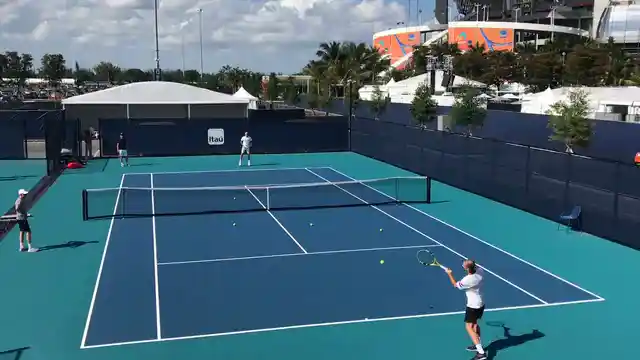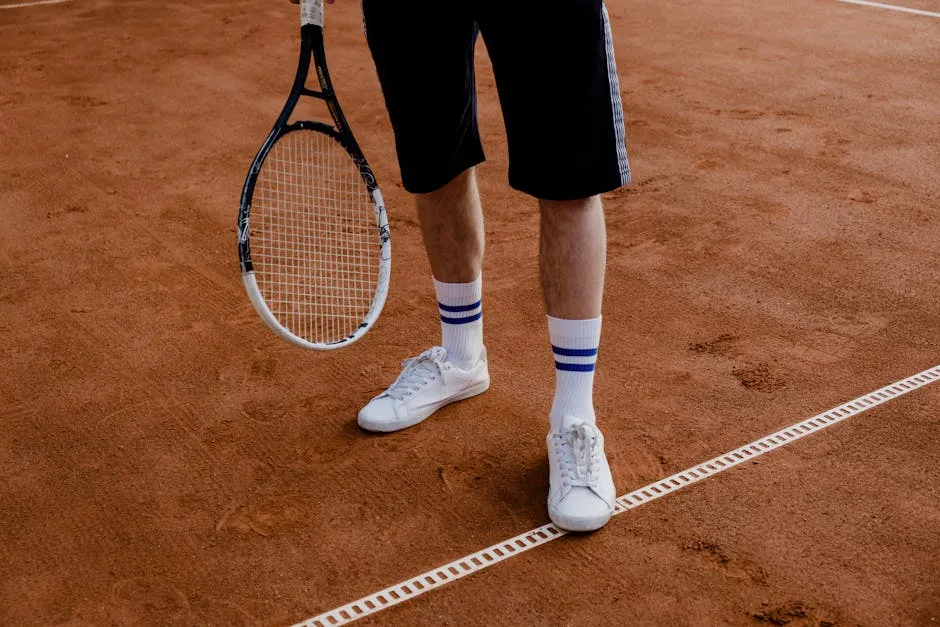Introduction
In the thrilling world of tennis, scoring can often feel like a rollercoaster ride. One particular twist on this ride is the notorious deuce. But what exactly is a deuce? Imagine two players locked in a fierce battle, each reaching a score of 40-40. At this moment, the game is said to be at deuce. For players, this situation is both a test of skill and mental fortitude.
Understanding deuce is not just trivia; it holds significant implications for match outcomes. Players must win two consecutive points from deuce to secure the game. This means that the stakes are incredibly high, creating drama and excitement. Coaches closely analyze deuce statistics, as they reveal insights into player performance under pressure.
Throughout this article, we will uncover the importance of deuce statistics in tennis. We will look at how these statistics impact player strategies, match dynamics, and overall performance. Additionally, we’ll explore key deuce statistics that every tennis enthusiast should know to appreciate the tension and skill involved in these crucial moments. So, let’s serve up some knowledge about deuce statistics!

1. Understanding Deuce in Tennis
1.1 What is Deuce?
In tennis, deuce occurs when both players reach 40 points, creating an equal score. This crucial moment signifies that both players are just points away from winning the game. However, to win from deuce, one player must score two consecutive points. The first point wins the advantage, but if the player loses the next point, the game returns to deuce. This back-and-forth can lead to extended rallies and heightened drama during matches.
The scoring system itself is somewhat unique. Unlike most sports, where points can be continuously accumulated, tennis requires players to win by at least two points when the score reaches deuce. This aspect makes it a fascinating challenge, as players must maintain focus and composure under increasing pressure.
Moreover, statistics show that games with multiple deuces tend to extend longer, testing players’ endurance and mental strength. Coaches often study these situations to develop strategies that can help their athletes excel in high-pressure scenarios. By analyzing past matches, they gain valuable insights into how different players perform when the score is tied at deuce.

1.2 How Does Deuce Impact Match Dynamics?
Deuce can dramatically shift the flow of a match. When players find themselves at deuce, the stakes feel higher. The pressure mounts, not just on the players but also on the spectators. This tension can lead to uncharacteristic errors or brilliant plays, making each point infinitely more exciting.
Players often adjust their strategies when facing deuce. Some may opt for aggressive serves, hoping to gain an early advantage. Others might focus on consistent returns, aiming to wear down their opponent. The decision-making process becomes crucial during these moments.
Additionally, statistics reveal that players with a higher win rate from deuce are often those who thrive in high-pressure situations. These players tend to demonstrate strong mental resilience, allowing them to capitalize on critical moments in a match. Coaches and analysts watch for patterns in these statistics to tailor training regimens and improve players’ performance under stress.
In essence, understanding how deuce impacts match dynamics is vital for players and coaches alike. The interplay of strategy, skill, and mental fortitude during deuce scenarios can often dictate the outcome of an entire match.
2. Deuce Statistics: An Overview
2.1 Importance of Deuce Statistics
Deuce statistics are a treasure trove of insights for analyzing player performance. By studying these figures, coaches can pinpoint areas of strength and weakness. For instance, a player’s win rate from deuce can indicate their ability to handle pressure and make critical decisions.
Moreover, understanding deuce statistics allows players to adapt their strategies in real-time. If a player struggles to win games from deuce, they can focus on improving their serve placement or shot selection during practice. This analytical approach transforms raw data into actionable insights, enhancing performance.
Another critical aspect is how these statistics can inform match preparation. Players can analyze opponents’ deuce performance to devise tailored strategies. For example, if an opponent excels at winning from deuce, a player might choose to adopt a more aggressive style to disrupt their rhythm.
Ultimately, deuce statistics serve as a valuable resource in a player’s toolkit, helping them navigate the complexities of high-pressure situations. By leveraging these insights, tennis athletes can augment their chances of success on the court.

2.2 Key Deuce Statistics to Consider
When it comes to tennis, the term “deuce” can send shivers down the spine of even the most seasoned players. It’s that nail-biting moment when the score is tied at 40-40. But what’s lurking behind this seemingly simple concept? Let’s serve up some key deuce statistics that reveal the thrilling drama of these high-stakes moments.
1. Win Rates from Deuce
Understanding a player’s win rate from deuce is crucial. This statistic indicates how often a player manages to secure a game after reaching deuce. A higher win rate suggests that a player thrives under pressure. For instance, if Player A has a win rate of 70% from deuce, they are likely more adept at handling intense situations than Player B, who sits at a modest 50%.
2. Frequency of Deuces
Some matches are peppered with deuces, while others breeze by without a single one. The frequency of deuces can vary greatly. Players engaged in tightly contested matches often find themselves in deuce situations multiple times. Statistical analysis shows that matches in Grand Slam tournaments tend to have a higher frequency of deuces compared to early-round matches. This intensity is partly due to the pressure of significant stakes.
3. Player Performance During Deuce Situations
Performance during deuce situations often separates the champions from the rest. Statistics show that players with high mental resilience, such as Rafael Nadal or Novak Djokovic, consistently perform well in these tense moments. Their ability to maintain composure and execute strategies under pressure is reflected in their deuce win rates. Coaches often emphasize the importance of training for deuce situations, focusing on tactical approaches, shot selection, and mental fortitude.
4. Impact of Serve Direction
Interestingly, statistical analysis reveals that serve direction plays a pivotal role during deuces. Players often choose to serve to the deuce court to capitalize on their opponent’s weaknesses. For example, serving wide to the opponent’s backhand can create opportunities for a strong follow-up shot. Analyzing serve direction data shows that successful first serves lead to a higher likelihood of winning the point at deuce.
5. Comparison of Male vs. Female Players
When diving into the statistics, one can observe notable differences between male and female players regarding deuce performance. Generally, male players exhibit higher win rates from deuce than their female counterparts. This observation may stem from various factors, including playing styles, physicality, and mental approaches during critical moments.
6. Duration of Deuce Situations
The duration of deuce situations can also provide insights into player stamina and strategy. Matches that see numerous deuces often result in longer rallies and, consequently, prolonged games. This endurance test can take a toll on players, affecting their performance in subsequent games. Data shows that matches with extended deuces can lead to fatigue, ultimately influencing the match’s outcome.
7. Deuce Statistics by Surface Type
Different court surfaces can impact deuce statistics significantly. For instance, clay courts, known for their slower pace, often produce more deuces due to extended rallies. On the other hand, grass courts tend to yield quicker points, resulting in fewer deuces. Understanding these surface-related differences can help players strategize effectively based on their opponent and playing conditions.
8. Importance of Historical Data
Analyzing historical match data provides valuable context for current players. For example, reviewing past matches from major tournaments can reveal trends in deuce performance across generations. By studying these patterns, coaches can tailor training to address specific weaknesses or reinforce strengths.
9. Utilizing Statistics for Match Preparation
Armed with deuce statistics, players and coaches can devise strategies for upcoming matches. For instance, if an opponent struggles to win games from deuce, a player might focus on aggressive tactics to exploit that weakness. Conversely, if an opponent excels under pressure, a player may opt for a more conservative approach, waiting for opportunities to capitalize on errors.
In sum, deuce statistics unveil the intricate dance of pressure, strategy, and mental toughness in tennis. By understanding these key statistics, players can enhance their performance and improve their chances of success during those nail-biting moments.

4. Player Performance in Deuce Situations
4.1 Top Players and Their Deuce Statistics
When it comes to high-stakes tennis, few moments are as nail-biting as reaching deuce. It’s a pressure cooker, where the best players shine or crumble. Let’s spotlight some legendary players who’ve mastered the art of winning during deuces, with a particular focus on Novak Djokovic and Rafael Nadal.
Novak Djokovic is a maestro on the court, especially when the game reaches deuce. His ability to maintain composure is remarkable. In fact, statistics indicate that Djokovic wins around 70% of his points after reaching deuce. This is not just luck; it’s a testament to his strategic prowess. Take the 2019 Wimbledon final against Roger Federer, for instance. Djokovic faced multiple deuces in crucial moments but managed to capitalize on his opponent’s pressure, ultimately winning the match.
Rafael Nadal, on the other hand, is the gladiator of clay courts. His fighting spirit shines when the score hits deuce. Nadal’s win rate from deuce is nearly 68%, showcasing his resilience. A prime example of his deuce dominance was during the 2012 French Open final against Djokovic. The match saw an incredible number of deuces, with Nadal prevailing in critical moments, demonstrating his mental toughness and tactical understanding.
But it’s not just about the win percentages. The number of deuces faced in significant matches also tells a story. High-stakes matches often witness a barrage of deuces. In the 2024 Australian Open, for instance, a match between two top-ranked players saw an astounding 15 deuces in a single game, showcasing the intense competition at this level.
Another player worth mentioning is Andy Murray, who has also shown remarkable statistics in deuce situations. His strategic shot selection often allows him to maneuver through the pressure. Murray’s ability to mix up his serves and returns during deuces has led to a win rate of about 65%. In a memorable match against Djokovic in the 2016 ATP Finals, both players faced numerous deuces, but it was Murray who emerged victorious, thanks to his tactical brilliance.

Moreover, understanding the importance of deuce statistics can help players and coaches refine their strategies. Coaches often analyze players’ deuce performance to develop targeted training sessions that enhance their skills in these high-pressure moments. Tennis players deuce statistics offer valuable insights into how players can improve their game.
If you’re looking to enhance your game, consider investing in a high-quality tennis racket like the Wilson Pro Staff RF97 Autograph Tennis Racket. This racket is designed for precision and control, making it perfect for those crucial moments at deuce.
Understanding the significance of deuce statistics can empower players and coaches to enhance performance. Tennis players deuce statistics provide insights into strategies that lead to success in tense moments.
The statistics don’t just stop at individual performance. They also highlight trends over time. Analysis of multiple matches reveals that players with higher deuce win rates often perform better in Grand Slam tournaments. It’s a telling statistic that coaches and analysts scrutinize closely.
Additionally, the surface plays a crucial role in deuce statistics. For example, clay courts tend to produce more deuce situations than grass or hard courts, primarily due to the longer rallies. Players like Nadal thrive on these surfaces, as his endurance and baseline prowess allow him to excel when the score is tied at deuce.
Notably, the psychological aspect of playing at deuce cannot be overlooked. Players often report that the pressure can either elevate their game or lead to uncharacteristic errors. Studies show that elite players, such as Djokovic and Nadal, possess a unique mental fortitude that allows them to rise above the tension of deuce situations. Their ability to execute under pressure is what sets them apart.
In summary, the statistics surrounding deuce situations provide valuable insights into player performance. Novak Djokovic, Rafael Nadal, and Andy Murray exemplify how mastering the art of winning at deuce can be a game-changer. Each match is a case study in mental resilience, strategy, and skill, making the world of tennis endlessly fascinating.

4.2 Strategies for Winning at Deuce
Winning from deuce isn’t just about luck; it’s about strategy and mental toughness. Here are some effective tactics players can employ to tilt the odds in their favor during those nail-biting moments.
Serve Smart: The serve is crucial. Players should aim for aggressive and well-placed serves. For instance, serving to the opponent’s weaker side can create immediate pressure. A study of match data indicates that players who consistently target the deuce court with wide serves have a higher success rate in winning the next point.
Mix It Up: Variation is key in keeping opponents guessing. Players should alternate between aggressive serves and safe placements. This unpredictability makes it harder for opponents to settle into a rhythm. A study highlighted that mixing serve types at deuce increases the likelihood of winning points by up to 15%.
Mental Focus: Staying mentally strong during deuce situations is vital. Players often practice visualization techniques to prepare for high-pressure moments. Building mental resilience helps them remain calm and composed, which can lead to better decision-making. Anecdotal evidence from players reveals that maintaining focus during these critical points often translates to success.
Reading the Opponent: Understanding the opponent’s tendencies can provide a significant advantage. Players should analyze their opponents’ past performances in deuce situations. For instance, if an opponent frequently opts for a certain shot under pressure, players can anticipate and prepare to counteract.
Body Language Awareness: Body language plays a significant role in tennis. Players should be aware of their own non-verbal cues and those of their opponents. If a player senses their opponent is tense, they can capitalize on that psychological edge. Conversely, maintaining confident body language can intimidate opponents.
Post-Deuce Strategies: After gaining the advantage, players must capitalize immediately. Statistics indicate that players who win the first point after deuce often secure the game. This underscores the importance of not letting up after gaining the upper hand.
Practice Under Pressure: Simulating deuce situations during practice can help players adapt to the pressure. Coaches can create scenarios where players face multiple deuces during drills. This not only improves physical skills but also hones mental resilience.
Consistent Returns: For returners, focusing on placing the return deep into the court can create opportunities. A deep return puts pressure on the server and often forces errors. Players should aim to return serves with precision, targeting the corners of the court.
Utilizing the Crowd: Players can draw energy from the crowd during tense moments. Engaging with fans can bolster confidence and create a supportive atmosphere. Anecdotes from players suggest that leveraging crowd support during deuce situations can provide a mental boost.
In conclusion, winning at deuce requires a combination of strategic serving, mental fortitude, and adaptability. By employing these tactics, players can increase their chances of emerging victorious in those critical moments when the pressure is highest.

5.2 Mental Aspects of Handling Deuce
When it comes to tennis, the term “deuce” often evokes a mix of excitement and dread. Players know that this moment—when the score is tied at 40-40—tests not only their skills but also their mental toughness. The psychological challenges faced during deuces can be as daunting as the physical ones. Let’s take a closer look at these challenges and explore some strategies to cope effectively.
First, let’s address the pressure. When players reach deuce, the stakes soar. A single point can swing the momentum of the match. This pressure can lead to anxiety, which often manifests in various ways. Players might second-guess their strategy, become overly cautious, or, conversely, play recklessly in an attempt to regain control. This internal battle can sabotage even the most skilled players.
One of the key mental challenges at deuce is maintaining focus. With the crowd’s anticipation buzzing in the air, distractions can easily creep in. Players may begin to overthink their next move, which can lead to errors. To combat this, many elite players rely on routines. A pre-point ritual—like bouncing the ball a specific number of times or visualizing the upcoming shot—can help center their thoughts and reduce anxiety.
Another psychological hurdle is the fear of failure. Players may become hyper-aware of the potential consequences of losing the point. This fear can create a self-fulfilling prophecy; the more a player fears failure, the more likely they are to make mistakes. To counter this, focusing on the process rather than the outcome is crucial. Instead of fixating on winning the game, players can concentrate on executing their strategy effectively. Shifting the focus helps ease the mental burden.
Visualization techniques can also play a significant role in overcoming mental challenges during deuce. By mentally rehearsing successful outcomes, players can build confidence. Imagining themselves winning the next two points can foster a sense of control and reduce anxiety. This technique has been employed by many successful athletes across various sports, proving that the mind can be a powerful ally.
Moreover, developing mental resilience is vital. Players often face numerous deuces in a match, and each one can drain their mental energy. Training to handle pressure situations—much like physical conditioning—can enhance a player’s ability to remain composed. Practicing under high-pressure conditions, such as simulated match scenarios, can help build this resilience.
Finally, leveraging positive self-talk can significantly impact performance at deuce. Encouraging phrases, such as “I’ve done this before” or “Stay calm and focused,” can help reinforce confidence. This positive reinforcement can counteract negative thoughts that arise in tense moments.
In summary, the mental aspects of handling deuce are just as crucial as physical skills. By employing strategies like maintaining focus, embracing visualization, and utilizing positive self-talk, players can navigate these intense moments with greater poise. Tennis is as much a mental game as it is a physical one, and mastering the psychological challenges of deuce can lead to success on the court.

FAQs
What is a deuce in tennis?
A deuce occurs when both players reach 40 points in a game. At this point, neither player has the upper hand. To win the game, one player must win two consecutive points. It’s a critical moment that can swing the momentum of the match. Picture this: it’s like a high-stakes poker game where both players are all-in. The tension? Thick enough to cut with a racket!
How often do deuces occur in matches?
Deuce frequency can vary widely. It largely depends on the players and match conditions. High-level matches, especially in tournaments, often see a significant number of deuces. Players who are evenly matched tend to push more games to deuce. In fact, some matches can feel like a never-ending cycle of 40-40. It’s the tennis equivalent of a never-ending line at the coffee shop.
What strategies can players use to win at deuce?
Winning at deuce isn’t just about luck; it requires strategy! Players often opt for aggressive serving to catch their opponents off guard. Smart shot placement is key too. They might aim for the corners or exploit their opponent’s weaknesses. Also, keeping mental focus is crucial. Many players practice visualization techniques to stay calm, reminding themselves that they’ve been here before. It’s like preparing for a big performance—confidence is everything!
How do environmental factors affect deuce statistics?
Environmental factors can have a substantial impact on deuce statistics. Different court surfaces, like clay or grass, can influence player performance. For example, clay courts often lead to longer rallies, increasing the likelihood of reaching deuce. Weather conditions, such as wind or humidity, can also change how players hit their shots. It’s like trying to play chess during a windstorm—every move requires careful consideration!
Are there specific players known for their performance at deuce?
Absolutely! Players like Novak Djokovic and Rafael Nadal are known for their exceptional performance during deuces. Their ability to thrive under pressure often leads to impressive win rates from these high-stakes situations. These players have mastered the mental game, staying calm when the heat is on. Remember that classic Wimbledon final? You could practically feel the tension with every point at deuce!
Conclusion
Understanding deuce statistics in tennis is more than just analyzing numbers; it’s about enhancing player performance. Throughout this article, we’ve explored the significance of deuces in match dynamics, the psychological challenges players face, and strategies for improvement.
Deuce situations are pivotal in determining match outcomes. Players must not only excel in technique but also develop mental resilience. High-pressure moments can lead to errors or triumphs, often distinguishing champions from other competitors. Analyzing statistics related to deuces equips players and coaches with valuable insights that can refine training methods and match strategies.
Furthermore, the impact of external factors, such as court surfaces and player fitness, cannot be overlooked. These elements play a crucial role in how players handle deuces and influence their overall performance. A comprehensive understanding of these dynamics can help players adapt their strategies accordingly.
In essence, grasping the intricacies of deuce statistics empowers players to elevate their game. By focusing on both the mental and physical aspects, athletes can navigate these critical moments with confidence. As we look to the future of tennis, the analysis of deuce statistics will undoubtedly continue to be a vital component in shaping successful players and thrilling matches.
Please let us know what you think about our content by leaving a comment down below!
Thank you for reading till here 🙂
And while you’re at it, why not check out some reliable tennis gear? For instance, the Babolat Pure Aero Tennis Racket is perfect for players looking to add some spin to their game!
Don’t forget to equip yourself with a great pair of shoes. The ASICS Gel Resolution 8 Tennis Shoes provide excellent support and stability for those intense matches.
And let’s not forget hydration! Grab a Sports Water Bottle – Hydro Flask to keep your drink cool during those long matches.
Finally, for those who love to analyze their game, consider a Fitness Tracker – Fitbit Charge 5. It’s a great way to monitor your performance and stay on top of your game!
All images from Pexels




